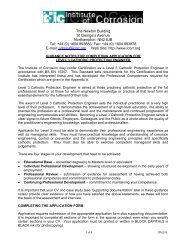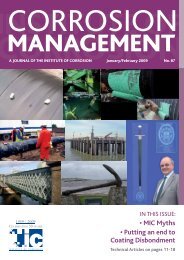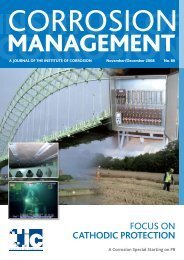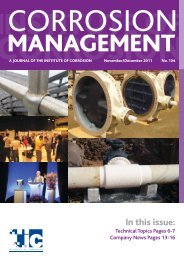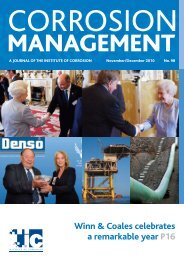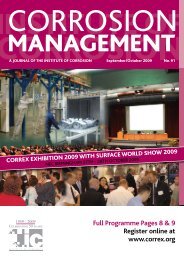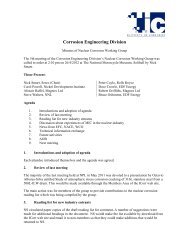<strong>Corrosion</strong>Management | March/April 2012FOCUSONcoating applicatorsFOCUSONCONSULTANTSMPM North West Ltd<strong>In</strong>stitute <strong>of</strong> <strong>Corrosion</strong> – Sustaining MembershipMPM North West Ltd is a family business,owned by <strong>the</strong> Hawkins family, based atMaryport Marina in West Cumbria. Thecore business is boatbuilding, repair andmaintenance and, over <strong>the</strong> years, <strong>the</strong>company has gained great experience in <strong>the</strong>application <strong>of</strong> coatings to cope with <strong>the</strong> mostextreme environments. It was <strong>this</strong> experiencealong with specialist knowledge <strong>of</strong> riggingsystems, that allowed MPM North Westto win <strong>the</strong> contract to repair and repaintBlackpool Tower.The job started in 2008 on an eight yearcontract, now slightly less due to <strong>the</strong> period<strong>of</strong> accelerated works in 2011 to get <strong>the</strong>new Tower Eye attraction ready to open forMerlin Entertainments who are <strong>the</strong> operators<strong>of</strong> Blackpool Tower for <strong>the</strong> Tower’s ownersBlackpool Council.MPM North West took possession <strong>of</strong> <strong>the</strong> siteas Principle Contractors and established aCDM regime which <strong>the</strong>y manage from <strong>the</strong>ir<strong>of</strong>fices which <strong>the</strong>y established at <strong>the</strong> 80 foot,ro<strong>of</strong>top, level. Workshop and welfare facilitieswere set up too along with a small towercrane which was cantilevered from a custombuilt base platform attached to <strong>the</strong> northwestern Tower leg.To access all parts <strong>of</strong> <strong>the</strong> Tower structureMPMNW install scaffold decks sequentiallywith <strong>the</strong> scaffold components being deliveredearly morning at <strong>the</strong> base <strong>of</strong> <strong>the</strong> Tower fromwhere <strong>the</strong>y are hoisted to ro<strong>of</strong>top level by<strong>the</strong> tower crane. From <strong>the</strong>re MPMNW use<strong>the</strong> same lifts as <strong>the</strong> public to transfer <strong>the</strong>scaffold up <strong>the</strong> Tower, <strong>the</strong> only differencebeing that <strong>the</strong>y travel at a slower speed andare carried, in purpose built frames,on top <strong>of</strong><strong>the</strong> lift! If <strong>the</strong> wind reaches 40mph <strong>the</strong> liftscannot run and work at <strong>the</strong> higher levels <strong>of</strong><strong>the</strong> structure have to be cancelled.Rope Access techniques, temporary lifelinesand nets are used until <strong>the</strong> scaffolding is inplace. Once completed <strong>the</strong> decks are fullyboarded with ply and sheeting is fixed in12 16place all round to contain debris within <strong>the</strong>scaffold and blasting <strong>the</strong>n commences.The water blasting is carried out usingJetstream Europe twin gun machines withBarracuda rotating heads made by StoneageWaterblast Tools working at a pressure <strong>of</strong>around 32,000 PSI. Operators have to undergosafety training and must wear protectivebody armour and steel reinforced wellingtonsto protect <strong>the</strong>m from <strong>the</strong> force <strong>of</strong> <strong>the</strong> water.The stripped bare steelwork is immediatelycoated with a single application <strong>of</strong> weldableprimer using airless spray equipment, byGraco, at an operating pressure <strong>of</strong> 6,800PSI. inspections are <strong>the</strong>n carried out by BWBStructural Engineers and MPMNW to evaluate<strong>the</strong> degree <strong>of</strong> corrosion sustained by <strong>the</strong>plates, bars, rolled sections and <strong>the</strong> millions<strong>of</strong> fixings, rivets and bolts, which make up <strong>the</strong>tower. Those corroded steel components withdegradation in excess <strong>of</strong> 20% are removedand replaced with new steel.MPMNW collaborated with AmtecConsultants Ltd and <strong>the</strong> technical staff <strong>of</strong>Hempel’s Paints to developed <strong>the</strong> new coatingsystem for <strong>the</strong> Tower; Hempel was founded in1915 in Denmark so that company’s historyis nearly as old at <strong>the</strong> Tower itself whichopened in 1894. Three coats are applied, twocoats <strong>of</strong> two pack epoxy paint, and a top coat<strong>of</strong> two pack polyurethane giving a minimum<strong>of</strong> 300 microns DFT. The top coat is red andcannot be changed without listed buildingconsent as <strong>the</strong> Tower is a Grade One listedbuilding. <strong>In</strong>terestingly, <strong>this</strong> colour has changedonce when permission was granted for <strong>the</strong>Tower to be painted gold for its centenarybut it had to return to its normal colour after<strong>the</strong> celebrations.The paint is being spray, brush and rollerapplied to suit <strong>the</strong> particular access <strong>issue</strong>sthroughout <strong>the</strong> complex steelwork structure.At laminar joints where <strong>the</strong>re is a risk <strong>of</strong>insufficient paint penetration all joints arecaulked with Sikaflex prior to <strong>the</strong> completion<strong>of</strong> <strong>the</strong> coating system and potentialwater traps are prevented by <strong>the</strong> judiciousapplication <strong>of</strong> <strong>the</strong> same product. Preparationsand coatings are inspected by MPMNW’s<strong>In</strong>spector with auditing services provided byAmtec Consultants Ltd. .The existing paint being removed from <strong>the</strong>Tower is lead based so all waste is treatedas hazardous and is collected and containedwithin sealed drums. These are removedFor more information please contact: MPM NORTH WEST LTD, Marine Road, Maryport, Cumbria, CA15 8AYTel : 01900 810299 Fax: 01900 810245 Email:mikej@mpmnw.co.uk www.mpmarine.co.ukdown to ro<strong>of</strong>top level for storage prior tocraning <strong>of</strong>f for transport and disposal atlicensed sites under Environment Agencyapproved procedures. Stringent PPE routinesare practiced by MPMNW’s employees and<strong>the</strong> health <strong>of</strong> workers is monitored by regularblood tests.Tower Factsn Opened on 14th May 1894n 118 years old <strong>this</strong> yearn 518 feet 9 inches high 158 metresn Grade on listed buildingn Member <strong>of</strong> <strong>the</strong> Wold federation<strong>of</strong> Great Towersn Cost <strong>of</strong> building £290,000n 2,500 tons <strong>of</strong> steeln 93 tons <strong>of</strong> cast ironn Original admission 6d plus 6d to goto topn The Circus is positioned at <strong>the</strong> base<strong>of</strong> <strong>the</strong> Tower between <strong>the</strong> four legsn The Circus ring when flooded canhold 42,000 gallons <strong>of</strong> watern The present Ballroom was designedby Frank Matchamn The ballroom floor measures 120feet x 102 feet comprising <strong>of</strong> 30,602blocks <strong>of</strong> Mahogany, Oak andWalnut
FOCUSONcoating applicatorsFocusonconsultantsWedge Group GalvanizingPAINTING A PERFECT PROTECTIVE PICTUREGalvanizing has long been used within<strong>the</strong> construction industry to protect steelfrom corrosion, not only because <strong>of</strong> itsease <strong>of</strong> application, cost effectiveness andlong-term durability, but because <strong>of</strong> itsinherently sustainable qualities. Ongoingtechnological advances and new productdevelopments have made galvanizing anincreasingly environmentally-friendlyfinish, one which can be incorporated intoa variety <strong>of</strong> construction projects, bothlarge and small-scale. Trevor Beech <strong>of</strong>Wedge Group Galvanizing, <strong>the</strong> UK’s largesthot-dip galvanizing organisation, outlinessome <strong>of</strong> <strong>the</strong> key benefits <strong>of</strong> galvanizingand its sustainable qualities, as well ashighlighting a newly developed paint whichhas been produced specifically for use withgalvanized steel.“Steel is a vital raw material in <strong>the</strong>construction process, but it is highly proneto corrosion. <strong>In</strong> fact, figures suggest thatapproximately 4% <strong>of</strong> <strong>the</strong> world’s GDP islost each year due to corrosion, with onetonne <strong>of</strong> steel turning to rust every 90seconds – for every two tonnes <strong>of</strong> newsteel produced, one is made simply toreplace metal lost due to rust.The process <strong>of</strong> galvanizing involves cleansteel being dipped into molten zinc attemperatures up to 450˚C, where a series <strong>of</strong>zinc-iron alloy layers are formed to create aprotective coating which can provide up to60 years <strong>of</strong> maintenance-free life.As a process, galvanizing results in minimalwaste, as any zinc that doesn’t instantlyform a coating on <strong>the</strong> metal, remains in <strong>the</strong>galvanizing bath and is subsequently reused.<strong>In</strong>deed, zinc’s non-ferrous characteristicsenable it to be recycled again and againwithout any loss <strong>of</strong> its physical or chemicalproperties. Of course, galvanizing reallycomes into its own as a sustainablefinish because <strong>of</strong> its one-<strong>of</strong>f nature – <strong>the</strong>process only needs to be carried out at<strong>the</strong> beginning <strong>of</strong> <strong>the</strong> construction project,but result in an effective and long-lastingprotection against corrosion. There’s noneed for <strong>the</strong> process to be repeated, and<strong>the</strong>re’s no requirement for time and costintensivemaintenance. At end <strong>of</strong> life <strong>the</strong>galvanized products can also be removed,re-galvanized and re-used, as well as beingGalvanising in action.easily recycled with scrap created in <strong>the</strong>steel production process.The industry has also taken significant stepsover <strong>the</strong> past few years to enhance <strong>the</strong>process to reduce its overall environmentalimpact, moves which Wedge Group hashelped to lead <strong>the</strong> way. As a company, wehave implemented a number <strong>of</strong> highlyinnovativeelements to reduce waste andimprove energy efficiency. For example, wehave introduced sophisticated rainwaterharvesting and sustainable drainagesystems at <strong>the</strong> majority <strong>of</strong> our 14 plantsacross <strong>the</strong> UK, which has minimised <strong>the</strong>reliance on mains supply.Once steelwork has been galvanized, <strong>the</strong>recan be a requirement to add colour to <strong>the</strong>finish, perhaps to complement a company’sexisting branding. This can lead to major<strong>issue</strong>s with adhesion, as most types <strong>of</strong>paint simply cannot bond adequately to <strong>the</strong>surface. To ensure that <strong>the</strong> paint remains onFor more information please contact: Stafford Street, Willenhall, West Midlands, WV13 1RZTelephone: 01902 630311 Fax: 01902 36635 Website: www.wedge-galv.co.ukBlackpool Tram Depot.<strong>the</strong> surface <strong>of</strong> <strong>the</strong> steel, <strong>the</strong> paint must becompatible with <strong>the</strong> galvanized coating, acombination that will provide unparalleledcorrosion protection.Wedge Group Galvanizing is currently<strong>the</strong> sole UK distributor <strong>of</strong> Galvacoat, atwo-component polyurethane-basedpaint system which has been specificallydesigned for use on galvanized steel.Galvanizing provides an ideal primer for <strong>the</strong>paint, which is available in all RAL and BScolours at different levels <strong>of</strong> gloss, allowing<strong>the</strong> end contractor a huge degree <strong>of</strong> designfreedom. Once applied to galvanizedsteel via its one coat system, Galvacoatcan last for a minimum <strong>of</strong> 8-10 years,eliminating <strong>the</strong> need for repeated on-sitemaintenance and replacement costs. It hasalready proven to be a popular solution forspecialist signage manufacturer ASG, whorecently used <strong>the</strong> paint on steel gantriesinstalled on <strong>the</strong> forecourts <strong>of</strong> every Tescopetrol station in <strong>the</strong> UK.”13 17



